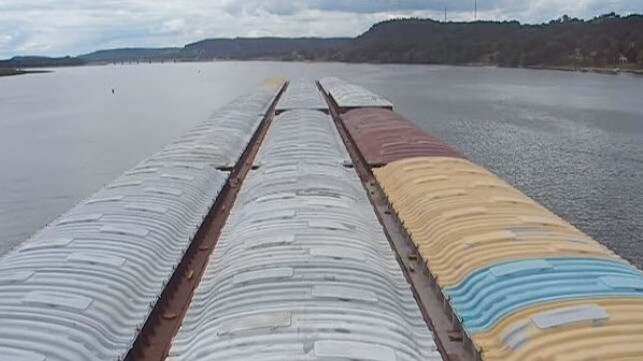Interview: Jennifer Carpenter, CEO of the American Waterways Operators

To start the new year, The Maritime Executive caught up with Jennifer Carpenter, president and CEO of the American Waterways Operators, for an update on what 2022 will look like on America's inland waterways. The year ahead is shaping up to be an eventful one for tug and towboat operators: between the final deadline for Subchapter M, the implementation of a giant $1 trillion infrastructure bill, the supply chain crisis and the beginnings of a new offshore wind industry, there will be plenty of challenges and opportunities to navigate in the months to come.
 TME: Can you tell us about what the new $1 trillion infrastructure package means for inland shipping? It contains a big boost for the Corps and sets aside a portion of the funding for waterways infrastructure - are there any specific projects that might benefit from this funding?
TME: Can you tell us about what the new $1 trillion infrastructure package means for inland shipping? It contains a big boost for the Corps and sets aside a portion of the funding for waterways infrastructure - are there any specific projects that might benefit from this funding?
It’s hard to overstate just what a big deal the Infrastructure Investment and Jobs Act is for the inland barge industry, the shippers who rely on it, and the American workers who will be employed to build and refurbish our lock and dam infrastructure. When you combine the $2.5 billion in full federal funding that the law provides for inland waterways construction and modernization with annual appropriations, we have the opportunity to complete almost two-thirds of the authorized projects on the Corps of Engineers’ to-do list over the next five years. That really is a generational opportunity. The industry’s message to the administration now is: first, thank you, and second, please spend that money wisely by following the Capital Investment Strategy jointly developed by the Corps and the Inland Waterways Users Board.
TME: 2021 was a banner year for U.S. offshore wind, with the issuance of BOEM's first ever EIS approval and a big pledge for more permits to come. Now that America's first full-scale wind farm is starting construction, what can we look forward to seeing next year?
2021 was also a banner year for U.S. maritime companies who are ready, willing and able to support the buildout of offshore wind, the biggest emerging market for the domestic maritime industry in decades. That’s because on January 1, 2021, Congress enacted a provision in the National Defense Authorization Act clarifying that all U.S. laws, including the Jones Act, apply to renewable energy development on the Outer Continental Shelf. The win-win potential ahead is huge: we have the opportunity to work together to create a great new American clean energy industry with a made-in-America supply chain. There’s a lot of work ahead and the Administration’s timeframes are ambitious, so my hope for 2022 is that wind developers and vessel owners get down to business and start signing contracts to accelerate the development of more U.S.-owned, U.S.-built, U.S.-crewed vessels to serve this exciting new market.
TME: The towing industry has been hard at work on implementing Subchapter M requirements since the new regulations took effect in 2018. What kind of impact has Sub M had on the industry, and what are the challenges remaining for full implementation?
The goal of Sub M was to build on the good work of AWO members and other responsible operators and raise safety standards industry-wide. AWO members have invested millions of dollars in safety management systems, equipment upgrades and training to make sure 100 percent of their fleets have COIs by the July 19, 2022 deadline, and we’re counting on the Coast Guard to hold the entire industry accountable for meeting that deadline, which has been a long time coming. We’ve begun to see the retirement of marginal equipment and I expect that trend to accelerate as the final regulatory deadline approaches. That will make our waterways safer and create a more level playing field for quality operators – good news all around.
TME: Can you tell our readers a bit about AWO's role in setting standards and helping members attain Sub M compliance?
AWO members were early adopters of safety management systems. Whether they choose to use the TSMS option or the Coast Guard option for Sub M compliance, all AWO members commit to implementing and maintaining a third-party-audited SMS when they join the association. This has given AWO members a big leg up in preparing for and achieving compliance with Sub M and, for members using the TSMS option, it’s allowed them to use their existing SMS and audit process as a compliance verification mechanism. AWO has also worked – and will continue to work – with members and the Coast Guard to ensure practical interpretations and consistent application of regulatory requirements and troubleshoot challenges as they arise.
TME: How has inland shipping helped with addressing some of the key challenges of the 2021 supply chain crisis? Could 'marine highway' capabilities be further leveraged to move containers from key seaports to inland markets?
The essential workers of the domestic tugboat, towboat and barge industry in the inland, coastal and non-contiguous trades have been indispensable to keeping vital commodities moving during the pandemic and supply chain crises of the past two years. They’ve showed up to work, day in and day out, they’ve kept vessels moving, and they’ve gotten the job done for their customers and for the country. Despite all the challenges of 2020 and 2021, we haven’t seen delays, bottlenecks, or rate instability in the domestic “Jones Act” market, which is a success story we need to tell and build on. Barge transportation also added crucial resilience to the inland transportation system during the Colonial Pipeline outage caused by the ransomware attack last year, as barges were able to move fuel to river cities like Nashville, Paducah, and Evansville, IN, keeping gas pumps supplied. Going forward, I think we will see shippers increasingly interested in exploring the opportunities for supply chain resilience and lower carbon footprint that greater reliance on “marine highways” can bring.
TME: The Jones Act has always drawn attention from free-market critics, who contend that it raises costs and inhibits growth. How would you respond to this critique, and how does Jones Act trade underpin America's maritime economy?
To those critics I would say, “Look back over our collective experience of the last two years and imagine how much worse things would have been had we not had the benefit of the reliable, resilient, cost-effective transportation made possible by the domestic maritime fleet that operates under the ground rules set by the Jones Act.” To take just one example, think about what would have happened had Americans living in Hawaii or Puerto Rico had to rely on international carriers to stock their shelves at a time of skyrocketing rates, displaced containers, and massive delays in the international shipping market. The Jones Act provides reliability for American businesses and consumers, resilience for the U.S. economy and supply chain, as well as national and homeland security benefits to our country that are more relevant than ever. I’d also say to those critics: there’s no shame in changing your views based on data and experience – the Jones Act works and it has proven its value, again.
TME: In the wake of COP26, many leading players in the maritime industry are looking at voluntary opportunities to reduce emissions. How can inland operators contribute to this shift in the coming year?
Sustainability is another domain in which the tugboat, towboat and barge industry is more relevant than ever. One of the most impactful things a shipper can do today to reduce the carbon footprint of their supply chain is to commit to moving more cargo by barge, which produces 30 percent less greenhouse gas emissions than rail and more than 1,000 percent less than trucks. Barge and towing vessel operators are also actively working to improve on their industry-leading environmental performance. Concrete steps range from fuel efficiency improvements that are being implemented today, using technology that’s already on board, to vessel repowers, to pilot projects and newbuilds using low- or zero-carbon fuels. AWO published a set of environmental sustainability best practices last year as a resource to help our members further build on their commitment to continuous improvement in this area.

that matters most
Get the latest maritime news delivered to your inbox daily.
TME: Several European OEMs are introducing technology for automated navigation in inland and coastal shipping, including the possibility of unmanned, autonomous vessel operations. How has this technology been received in the U.S. inland shipping industry, and what might its potential be in the American market?
Autonomous is interesting, but automation is here today and presents huge opportunities for safety and efficiency improvements. I see AWO members embracing opportunities to realize the benefits of increased automation (in engine rooms, for example) in ways that are attainable now. As we go forward, we need to make sure that vessel crewing statutes and regulations enacted in the days of “coal passers” and “water tenders” are modernized, and that the Coast Guard has the flexibility to establish safe crewing levels for the vessels of today, not those of 100 years ago.
